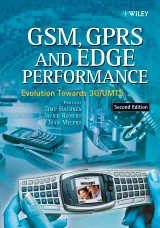Details

GSM, GPRS and EDGE Performance
Evolution Towards 3G/UMTS2. Aufl.
|
110,99 € |
|
| Verlag: | Wiley |
| Format: | |
| Veröffentl.: | 02.04.2004 |
| ISBN/EAN: | 9780470866955 |
| Sprache: | englisch |
| Anzahl Seiten: | 656 |
DRM-geschütztes eBook, Sie benötigen z.B. Adobe Digital Editions und eine Adobe ID zum Lesen.
Beschreibungen
GSM, GPRS and EDGE Performance - Second Edition provides a complete overview of the entire GSM system. GSM (Global System for Mobile Communications) is the digital transmission technique widely adopted in Europe and supported in North America. It features comprehensive descriptions of GSM’s main evolutionary milestones - GPRS, (General Packet Radio Services) is a packet-based wireless communication service that promises data rates from 56 up to 114 Kbps and continuous connection to the Internet for mobile phone and computer users. AMR and EDGE (Enhanced Data GSM Environment), and such developments have now positioned GERAN (GSM/EDGE Radio Access Network) as a full 3G radio standard. The radio network performance and capabilities of GSM, GPRS, AMR and EDGE solutions are studied in-depth by using revealing simulations and field trials. <p>Cellular operators must now roll out new 3G technologies capable of delivering wireless Internet based multimedia services in a competitive and cost-effective way and this volume, divided into three parts, helps to explain how:</p> <p>1. Provides an introduction to the complete evolution of GSM towards a radio access network that efficiently supports UMTS services (GERAN).</p> <p>2. Features a comprehensive study of system performance with simulations and field trials. Covers all the major features such as basic GSM, GPRS, EDGE and AMR and the full capability of the GERAN radio interface for 3G service support is envisaged.</p> <p>3. Discusses different 3G radio technologies and the position of GERAN within such technologies. </p> <p>Featuring fully revised and updated chapters throughout, the second edition contains 90 pages of new material and features the following new sections, enabling this reference to remain as a leading text in the area:</p> <ul> <li>Expanded material on GPRS</li> <li>Includes IMS architecture (Rel’5) and GERAN (Rel’6) features</li> <li>Presents field trial results for AMR and narrowband </li> <li>Provides EGPRS deployment guidelines</li> <li>Features a new chapter on Service Performance</li> </ul> <p>An invaluable reference for Engineering Professionals, Research and Development Engineers, Business Development Managers, Technical Managers and Technical Specialists working for cellular operators<br /> </p>
Acknowledgements. <p>Foreword.</p> <p>Introduction.</p> <p>Abbreviations.</p> <p>PART 1: GERAN EVOLUTION.</p> <p>1. GSM/EDGE Standards Evolution (up to Rel'4) (M. Hakaste, <i>et al</i>.).</p> <p>2. Evolution of GERAN Standardisation (Rel'5, Rel'6 and beyond) (E. Nikula, <i>et al</i>.).</p> <p>3. GERAN QoS Evolution Towards UMTS (E. Ala-Tauriala, <i>et al</i>.).</p> <p>4. Mobile Station Location (M. Weckström, <i>et al</i>.).</p> <p>PART 2: GSM, GPRS AND EDGE PERFORMANCE.</p> <p>5. Basics of GSM Radio Communication and Spectral Efficiency (J. Melero, <i>et al</i>.).</p> <p>6. GSM/AMR and SAIC Voice Performance (J. Melero, <i>et al</i>.).</p> <p>7. GPRS and EGPRS Performance (J. Romero, <i>et al</i>.).</p> <p>8. Packet Data Services and End-user Performance (G. Gomez, <i>et al</i>.).</p> <p>9. Dynamic Frequency and Channel Allocation (M. Salmenkaita).</p> <p>10. Narrowband Deployment (A. Rivada, <i>et al</i>.).</p> <p>11. Link Performance Enhancements (R. Pirhonen, <i>et al</i>.).</p> <p>12. Control Channels Performance and Dimensioning (T. Kähkönen & J. Navarro).</p> <p>13. Automation and Optimisation (V. Wille, <i>et al</i>.).</p> <p>PART 3: 3G EVOLUTION PATHS.</p> <p>14. IMT-2000 3G Radio Access Technologies (J. Melero, <i>et al</i>.).</p> <p>15. 3G Technology Strategy and Evolution Paths (J. Melero).</p> <p>Appendix A: MAIO Management Limitations.</p> <p>Appendix B: Hardware Dimensioning Studies.</p> <p>Appendix C: Mapping Link Gain to Network Capacity Gain.</p> <p>Appendix D: Interference between GSM/EDGE and Other Cellular Radio Technologies.</p> <p>Appendix E: Simulation Tools.</p> <p>Appendix F: Trial Partners.</p> <p>Index.</p>
"This book is a one-stop shop for everything you want to know about GPRS and EDGE systems…would be a valuable reference…" (<i>E-STREAMS</i>, July 2004)
<p><b>Timo Halonen</b> is the editor of <i>GSM, GPRS and EDGE Performance: Evolution Towards 3G/UMTS</i>, 2nd Edition, published by Wiley.</p> <p><b>Javier Romero</b> is the editor of <i>GSM, GPRS and EDGE Performance: Evolution Towards 3G/UMTS</i>, 2nd Edition, published by Wiley.</p> <p><b>Juan Melero</b> is the editor of <i>GSM, GPRS and EDGE Performance: Evolution Towards 3G/UMTS</i>, 2nd Edition, published by Wiley.</p>
Now fully revised and updated throughout, GSM, GPRS and EDGE Performance continues to provide a complete overview of the entire GSM system. It presents comprehensive descriptions of GSM’s main evolutionary milestones – GPRS, AMR and EDGE and explains how such developments have positioned GERAN (GSM/EDGE Radio Access Network) as a full 3G radio standard. For the first time in one volume, the radio network performance and capabilities of GSM, GPRS, AMR and EDGE solutions are studied in-depth by using revealing simulations and field trials. This volume explains how cellular operators can roll out new 3G technologies capable of delivering wireless Internet based multimedia services in a competitive and cost-effective way. <p>Divided into three parts:</p> <ol> <li> <div>Provides an introduction to the complete evolution of GSM towards a radio access network that efficiently supports UMTS services (GERAN).</div> </li> <li> <div>Features a comprehensive study of system performance with simulations a nd field trials.</div> </li> <li> <div>Discusses different 3G radio technologies and the position of GERAN within such technologies. </div> </li> </ol> <p>Written by leading experts in the field, this performance-oriented and practical approach to the GSM system and its evolution will have far-reaching appeal to Engineering Professionals and Research & Development Engineers. It will also be an instant hit with Technical staff and Management working for cellular operators.</p> <p>Key updates of the Second Edition:</p> <ul> <li> <div>Includes GERAN Rel'5 and Rel'6 functionality, including Single Antenna Interference Cancellation (SAIC)</div> </li> <li> <div>Expands the QoS chapter to cover end to end system aspects</div> </li> <li> <div>Presents field trial results for GPRS, AMR, SAIC and EDGE</div> </li> <li> <div>Provides EGPRS deployment guidelines in various deployment scenarios</div> </li> <li> <div>Features a new chapter on “Service Performance"</div> </li> </ul>


















